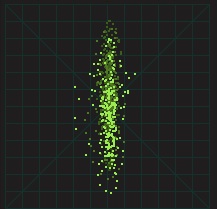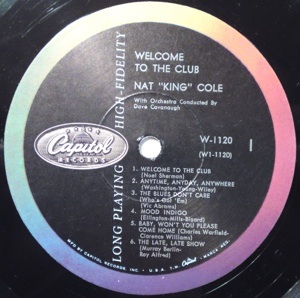
(My thanks to SH.TV members Ere, JTaylor, ShawnMcCann, and Stevelucille for contributing samples used (along with my own) on this page.)
Welcome to the Club was recorded in the summer of 1958, prior to Capitol’s initial stereo LP releases, but was not released until February, 1959, several months after those initial stereo disks. Regardless, that delayed, initial release was strictly mono only. (The stereo release did not occur until May.)
The mono release was a typically good-sounding, “hi-fi” Capitol album, with warm tone and intimate perspectives for the most part. Because this is a multi-mic (seven mics, perhaps) recording, the rhythm section is far more present here than in the stereo 3-mic recording made simultaneously.
Let’s compare a few different mono releases. Below, you will hear Ere’s D2 pressing, followed by ShawnMcCann’s “D1 #2” pressing. The transition occurs at the word “‘cause.” Have a listen: MonoBluesReduxD1Ere-D1McCann.mp3
Initial release: Mono only - February, 1959. Photo: Ken Hawkins
To my ears, the D3 is not quite as warm and rich as the two D1 samples, but the differences are fairly slight. Both sound quite nice, in my opinion.
In 1962, there was a mono reissue of all 11 tracks, but in a jumbled order, on an LP entitled, “The Swingin’ Side of Nat ‘King’ Cole,” but we have no samples for comparison at this point. Also, Welcome to the Club was included as one of the three albums in The Nat King Cole Deluxe Set.
Mono CD tracks
In 1991, the CD Big Band Cole stated (on the back cover) that the 3-track tapes for two LP tracks, “Look Out for Love” and “Wee Baby Blues,” along with the non-LP track “Madrid,” could not be found. (They since have been located.) As a result, that CD contains these tracks in mono from the original mono mix. How does that CD release hold up when compared to the original mono LPs? Below, you can hear two samples, each starting with my D3 pressing, transitioning into the Big Band Cole track, as mastered from mono by Malcolm Addey. Below left: The brass opening; Below right: a brief vocal passage.
Brass: WeeBabyMonoReduxD3-BBC-cr.mp3 Vocal: WeeBabyVocalD3-BBC-cr.mp3
Next, click the photo below to compare Ere’s D2 with a D3 from my collection:
Tonally, the LP and CD are similar, and the dynamics are unaltered, which is good to hear. There are some tape dropouts on the CD, and clearly a stereo tape head was used to play back the mono tapes, but in addition, some stereo widening was applied, although it is fairly subtle. Specifically, it’s almost non existent in the quiet parts, and grows more pronounced as volume increases. Below are three scope readings. The sample at left shows the mono LP. (A straight vertical line = pure mono.) Center is a loud brass section from the left sample above. Right is the vocal sample heard above.



Reel-to-Reel
To my knowledge, there was no stereo reel-to-reel release of this album, but in Britain, there was a release in 1966 by EMI’s World Record Club on 3.75 ips mono reels. SH.TV member “stevelucille” was kind enough to send a sample, heard below. Please listen carefully to the drums and to the sax solo at the end of the 25-second clip. You will hear the clip three times in a row. First time: My mono D3 original. Second time: The tonally-poor reel-to-reel. Third time: My original UK stereo LP, folded down to mono. Click on the tape box below to hear the sample.
What’s going on in those samples? Remember: The mono mix used more mics, probably 7 total, vs. 3 for the stereo. Note how close the drums sound in sample #1, and how present the sax solo is? That’s due to more and closer-in microphones being used. The tape sample, while in mono, is (oddly) a FOLD-DOWN from the 3-mic stereo mix. Compare the drum and sax solo “distance” between the second and third clips. Ignoring the poor tone of the tape copy, the distances are the same. The mono tape is a fold-down. The mono LP uses the original mono mix.



